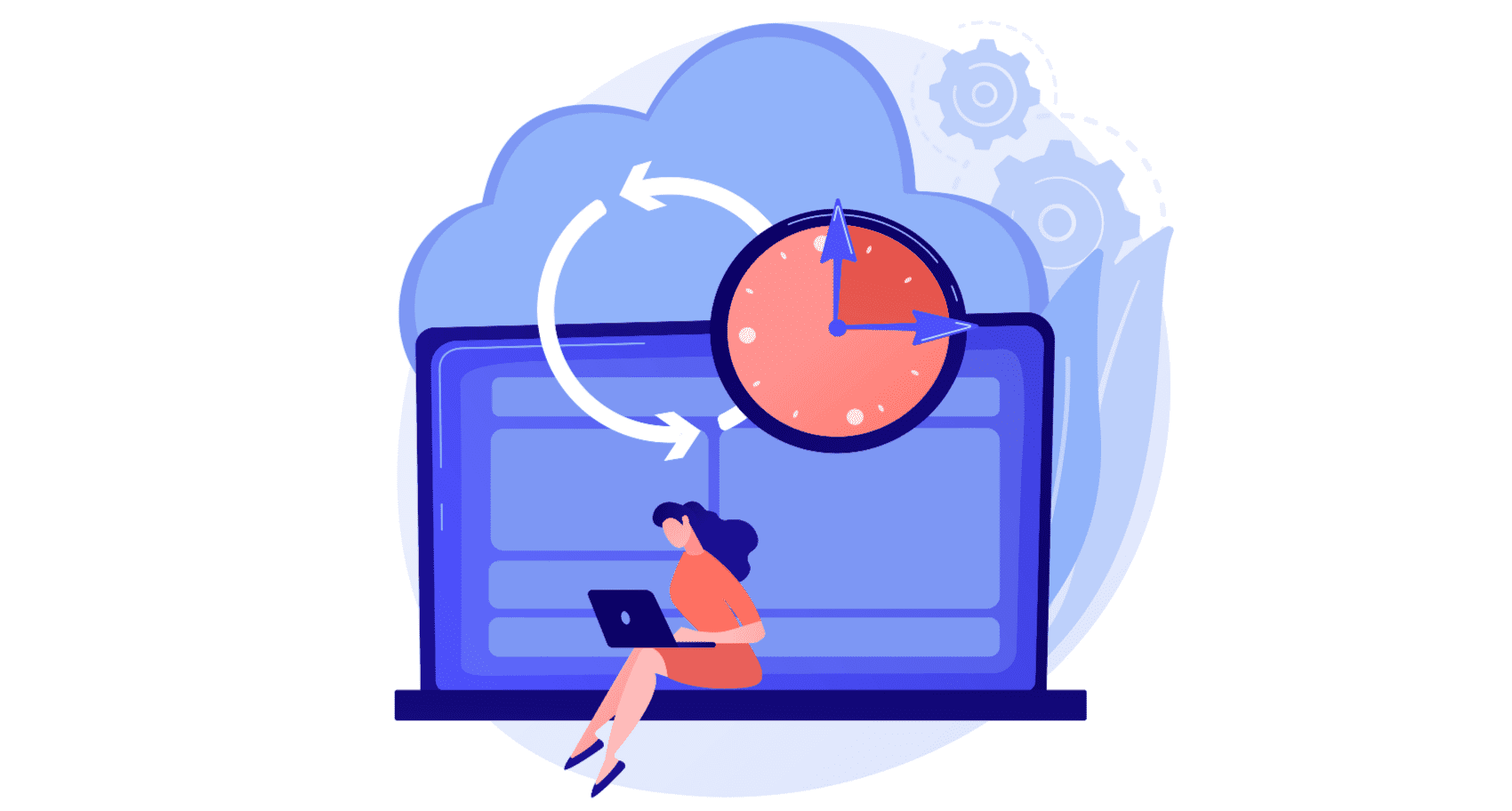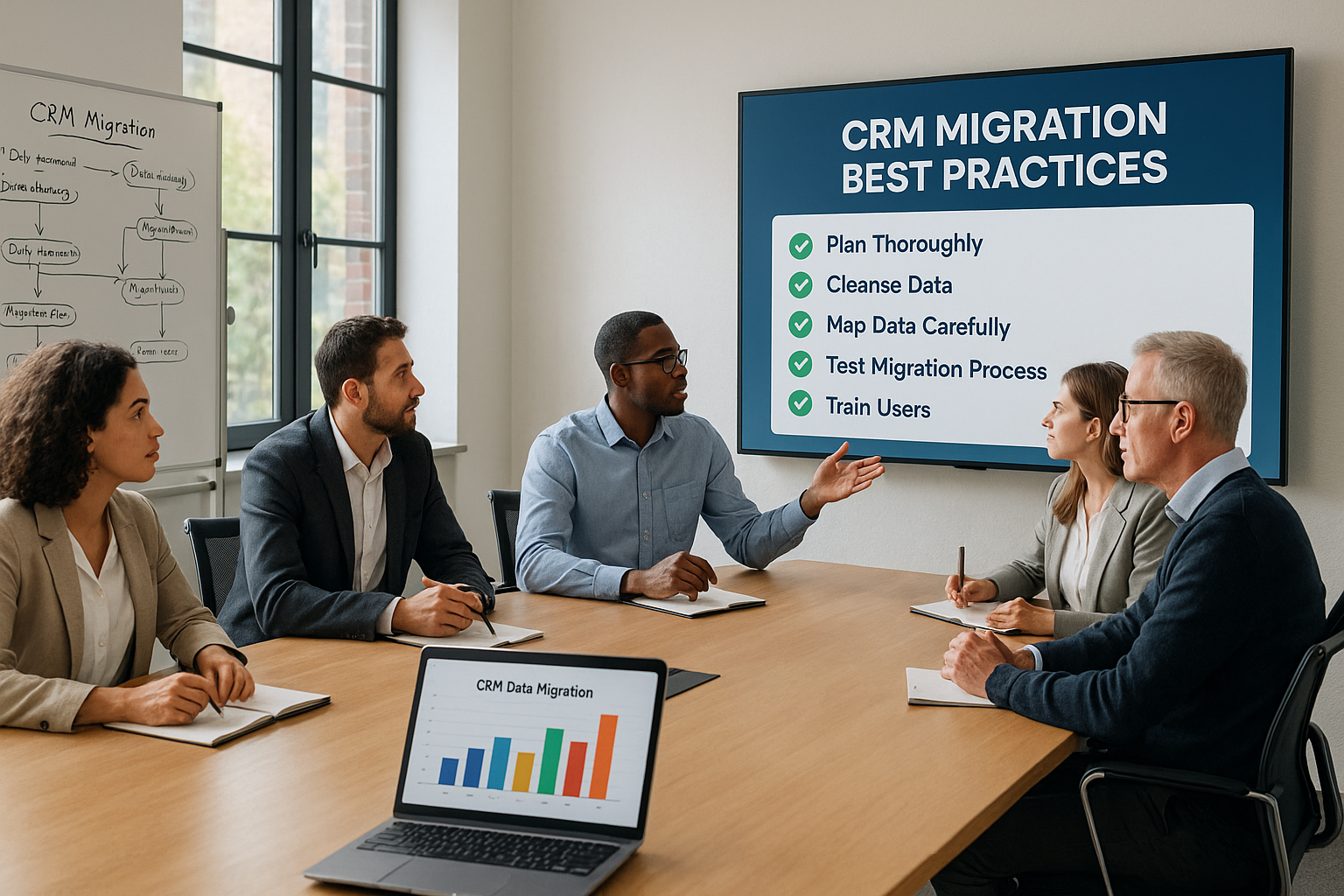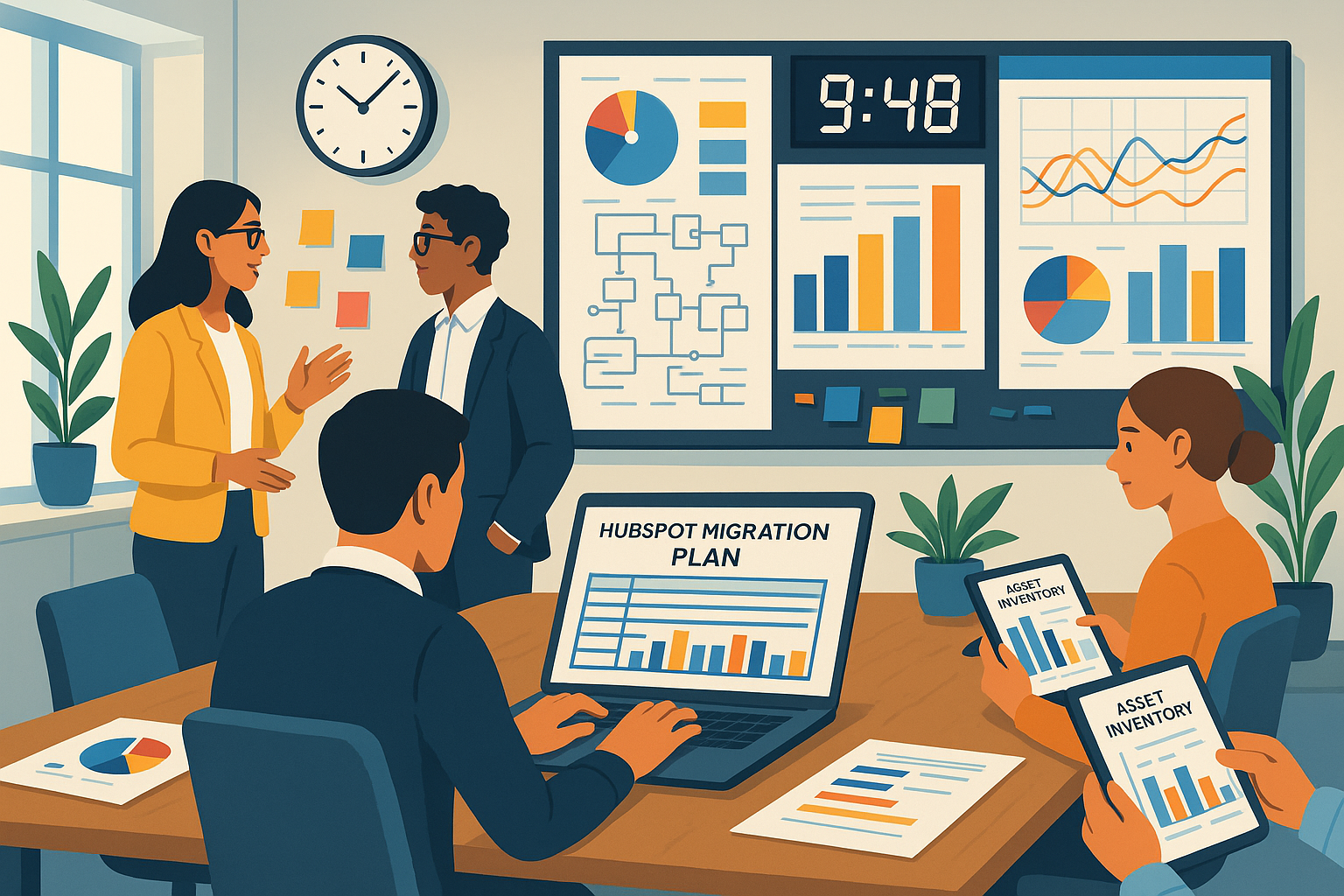Fortunately, there are measures you can take to ensure a successful migration project. This article will walk you through the preliminaries of finding and evaluating your data, along with the six steps to a practical test plan.
What is Data Migration Testing?
Migration testing is a process that checks the migration of the legacy system to the new system with minimal disruption or downtime, with data integrity, and with no data loss. It guarantees that all the application's specified functional and non-functional criteria are met post-migration.
For example, you can migrate your data to such leading CRM systems as:
- HubSpot
- Salesforce
- Freshsales
Why Test a Migration?
As we know, application migration to a new system could be necessary for several reasons, including system consolidation, obsolete technology, optimization, or any other factors.
Therefore, it is important to ensure the following points even though the system in use needs to be migrated to a new system:
- It is important to prevent or minimize any user disruptions or inconveniences caused by the migration. For example, downtime, or data loss.
- It is necessary to verify that the user can continue to use all the functions of the software by causing minimal or no damage during migration. For instance, changing or removing a certain functionality.
- Additionally, it's crucial to anticipate and minimize any possible issues or glitches that might happen during the actual migration of the live system.
Thus, it is essential to perform data migration testing in the lab in order to ensure a seamless migration of the live system by eliminating those defects. This testing has its importance, and it plays a crucial role when the data comes into the picture.

Technically, it also should be performed for the following reasons:
- To ensure that the new or updated system is compatible with any hardware or software that the legacy application supports. In addition, new compatibility should be tested for new hardware and software platforms.
- To make sure that the current features work as they did in the legacy application. When compared to legacy software, there shouldn't be any differences in how the new one works.
- It's extremely likely that migration will result in many defects. Since many errors will typically be related to data, these defects need to be found and corrected during the testing process.
- To ensure whether the system response time of the new or upgraded application is the same or less than that of the legacy application.
- To make sure that all servers, hardware, software, etc. are connected properly and do not fail during testing. Data flow between various components shouldn't break under any condition.
Understand the Data Your Business Runs On
The modern business runs on data. It is the fabric that keeps companies connected, informed, and competitive. Before attempting a data migration, you must have a thorough understanding of what data you’re collecting and how it drives your core business processes.
If you are migrating from a legacy CRM system, this step is simple. You’ve already put considerable thought into your business processes, and all your data is stored in a single location.
But if you are trying out CRM software for the first time, you will need to go on a data finding mission. Data could be siloed on an individual’s computer, a department’s server, or a third-party application. It may even be in a pile of business cards, post-it notes, or receipts. You’ll need to find your company data in all its hiding places and all its formats.
Once you gather all the data, you’ll need to organize it. The people who use the data daily are your unofficial experts. They will best understand the relationships between the data and the business’ core processes.
After you’ve cataloged the data, you can define your goals for the target system. What problems are you hoping to solve with your new software? If you are switching CRMs, make a note of any inefficiencies in the legacy system.

Create a Data Migration Timeline
Once you understand the size and scope of your data, you can accurately plan the data timeline. Downtime is one of the hidden costs of data migration. It has resulted in lost customers for 37% of businesses and lost revenue by 17%. Having a timeline with dependencies and milestones helps minimize your downtime and ensures the migration plan and data migration testing methodology go smoothly.
6 Steps to an Effective Data Migration Test
Every business is different, but the following six steps are typical for most data migration projects. When assigning a timeframe for each step, consider the following: size and complexity of data, migration method, number of key players, and optimum delivery time (as determined by management).
1. Data Cleansing
The more data you have, the more costly and time-consuming a data migration process will be. It makes sense to examine your data and limit the migration to what is essential. Clean up your data by:
-Removing historical data you no longer use.
-Deleting duplicate records.
-Filling out incomplete records.
It is also a good idea to evaluate your data structure. Remove any unnecessary objects, fields, tags, and other entities. You want to be sure your target system doesn’t inherit the problems and inefficiencies found in the old one.
During this process, you should carefully document your data’s scope and what you will include and exclude from the migration.
2. Choose Your Data Migration Method
Many CRMs have a native migration tool. First, you must save your data to CSV (comma-separated values) files. This allows you to retain the structure of your data in tables.
Then you upload the files to your target CRM. A CSV migration is one of the easiest and least technical methods if the new and legacy CRM systems are similar.
Some CRMs do not accept all types of data via CSV files. For example, the popular CRM, HubSpot, cannot import notes, calls, tasks, or emails via CSV. So, there’s often a trade-off between simplicity and scope.
API endpoints are another method for migrating data. There are usually no restrictions on where data locates itself. You need a team of data specialists to perform an API migration.
A third option is to use a third-party service partner or app. For most businesses, this is the most cost-efficient and time-saving method for data migration strategy.
The timing of your migration approach is another important consideration. There are two data migration schedules: big-bang and trickle.
Big-Bang Migration: The entirety of your database transfers within a set period. The downside to this method is system downtime. The upside is you get the entire migration done in one go.
Trickle Migration: Trickle data migration is completed in phases while the legacy and target systems run parallel. This avoids downtime and its associated costs. Trickle migration is also reliable for continuous migration.
3. Backup Data Before Migration
Whatever migration method you use, you must backup your data. Data migration is a huge undertaking. It’s estimated that 83% of migrations fail or run over budget. Having a backup ensures you won’t lose the data your company runs on.
4. Examine the Source and Target CRM Systems
You’ll need to plan how the source data fits into the new CRM system. You should have documentation from the data cleansing step, which tells you the data types, structure, and number of records to be migrated.
Then examine the target system. You will need to know how each field and entity maps onto the new system. If you have any custom requirements, build them out in the target CRM before the sample migration.
From there, you can create a template for how the data maps from one system to another. If there is a significant disparity between CRMs, you may prefer to use a third-party service provider. Alternatively, you can use a data migration app. Most of these apps offer data matching templates.
MigrateMyCRM is unique in its flexibility. It automatically maps the data while still allowing you to customize fields and other entities.
5. Run a Sample Migration
A sample migration is when a subset of data is migrated. This dry-run approach allows you to catch mistakes before migrating your entire database. It’s also much more efficient than migrating your complete dataset repeatedly as you perfect your mapping. Ten percent of your records is a typical amount.
Running a trial migration can also help you prepare for any system downtime. Once you know how long it takes to migrate 10% of your database, you can extrapolate the entire migration timeframe. If it exceeds your project timeline significantly, you can try another migration method or tool.
After running a sample migration, it’s advisable to compare several records in the target and legacy systems. IT can check the records against the mapping document for accuracy. Meanwhile, CRM users can test the new system for usability and intent. Team members know the data they use intimately and can screen for problems IT might not notice. They can also better evaluate whether the new CRM is meeting its stated goals for the business.
If you are using a data migration tool, they usually come with sandbox testing. This means you can attempt multiple trial migrations. These automated tools make it easy to tweak the mapping if you get any unexpected results, and the process takes mere minutes.
Manual users will need to trace the original dataset, determine where each errant data point came from, and then recalculate the field values. This method is time-consuming and more prone to human error.
6. Complete Your Data Migration
Now you know how to test data migration, and once you’ve completed a trial migration that looks good to both IT and system users and you are satisfied with the result of migration, you can complete the migration process. Having a plan, timeline, back-up, and trial-run will prepare you for successful data migration.
SyncMatters has decades of experience migrating data and works with over 30 CRM vendors. Try a sample migration today.

Data Migration Testing Difficulties
Here`re the most typical challenges when it comes to data migration testing:
Ensuring data quality during migration
Poor data quality is caused by different factors, including assumptions, data conversions after migrations, poor data analysis, etc. To meet business standards in these situations, data quality must be improved.
Addressing data mismatch issues
Data migrated from the legacy to the new application may be found mismatched because of the change in data type, format of data stored, and so on. It results in huge efforts to modify or redefine, so it`s better to take the necessary steps to avoid data mismatch.
Preventing data loss in migration
When migrating from a legacy program to a new or upgraded application, data may be lost. This will cause a significant loss of data, which should be retrieved either from the backup database or audit logs if captured correctly.
Managing downtime for large data sets
Huge data sets can take a long time to migrate within the migration activity's downtime timeframe. Therefore, teams should thoroughly examine the data in the live system and come up with a typical analysis and sampling of the data. The most helpful solution, in this case, is automation.
Simulating real-time data for accurate testing
Simulating real-time data and a real system is one of the data migration testing challenges because it throws up problems that are not often seen during testing. Therefore, while carrying out migration test specifications, it is crucial to sample real data, replicate a real-time environment, and identify the volume of data during the migration activity.
It can be difficult to simulate real-time data since testing teams would have to carefully examine the data in the live system and produce a typical analysis and sampling of the data. Data creation needs to be done in the testing environment if data from life cannot be collected. To generate a high volume of data, they have to use automated tools, and if they cannot simulate the volume, they should use extrapolation.
Strategies for effective data migration testing
The data migration testing approach is so complex that it is necessary to carefully study the system before and after migration. Additionally, it includes hiring skilled and well-trained testers, planning and creating an efficient data migration test strategy, and using reliable tools. Smooth migration is a difficult process that shows the quality of the application. Migration testing is successful when functionality, performance, usability, security, reliability, compatibility, etc. are all verified.
Disadvantages of Data Migration
Cost
Each stage of the migration process has a direct impact on the cost. This can be the consequence of wrong planning, data analysis, or bad business strategy, which raises operational expenses and deviates from the company`s goals. Therefore, it's crucial to keep the process execution ideal.
Time
Time is very important in data migration because each level of migration has its own impact on it, including total migration time, application downtime, record migration time, and rollback time.

Tips to Reduce the Risks of Data Migration
Successful data migration includes the following recommendations to minimize the risks:
- Standardize data in legacy systems so that when they are moved, the new system will have access to the standard data.
- Improve the data's quality so that when it is moved, there is qualitative data to test, giving the feel of testing as an end-user.
- Before migrating, clean the data so that duplicates won't appear in the new system. This also keeps the entire system clean.
- Check the constraints, complex queries, and stored procedures, that produce accurate results once the data has been transferred to ensure that the new system also receives the correct data.
- Choose the right automation tool to perform data and record checks between the new and legacy systems.
To Sum Up
Data migration is the process of moving data from one place to another, one format to another, or one app to another. Usually, this is the result of introducing a new software or location for the data. Therefore, we advise you to create a data migration testing strategy according to your business goals.





